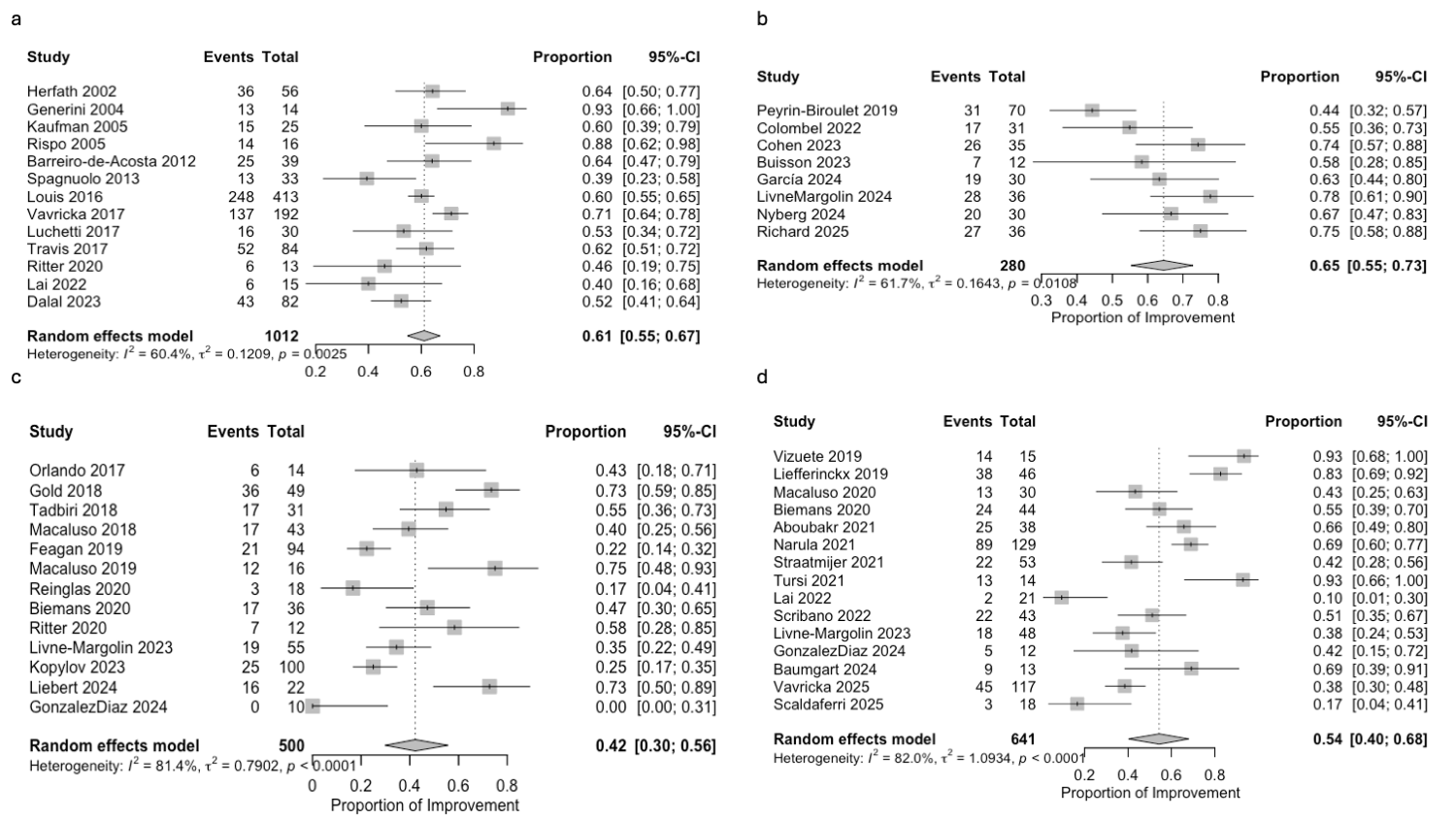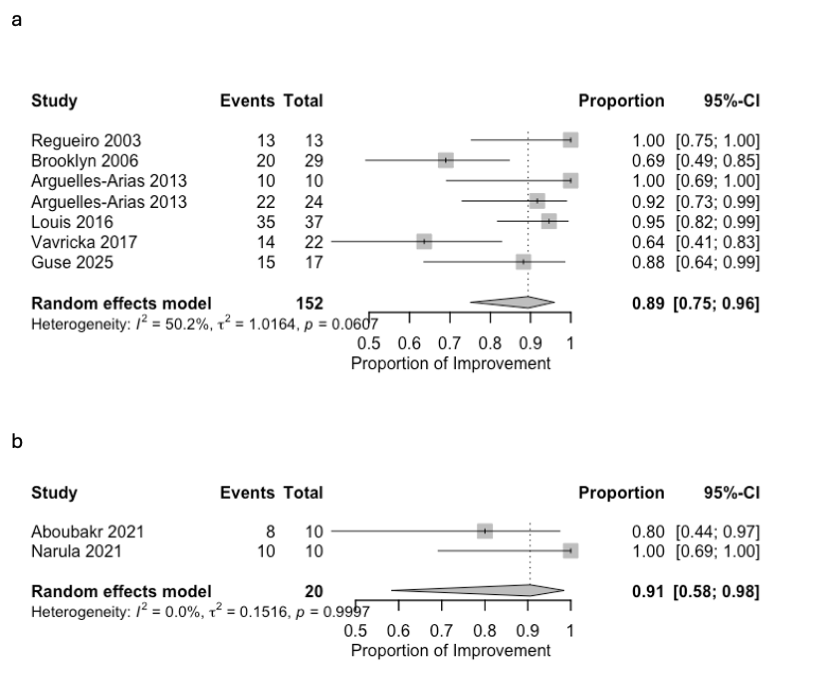Tuesday Poster Session
Category: IBD
P5458 - Advanced Therapies for Extraintestinal Manifestations of IBD: Systematic Review and Meta-Analysis
Tuesday, October 28, 2025
10:30 AM - 4:00 PM PDT
Location: Exhibit Hall

Karan Sachdeva, MBBS, MPH
SUNY Upstate Medical University
Syracuse, NY
Presenting Author(s)
Karan Sachdeva, MBBS, MPH1, Dhruv Manik, BA2, Tarun Chhibba, MD3, Ashwin Ananthakrishnan, 4
1SUNY Upstate Medical University, Syracuse, NY; 2Boston University Chobanian & Avedisian School of Medicine, Boston, MA; 3Massachusetts General Hospital, Harvard Medical School, Boson, MA; 4Division of Gastroenterology, Massachusetts General Hospital and Harvard Medical School, Boston, MA
Introduction: Extraintestinal manifestations (EIMs) occur in over one-fifth of patients with Inflammatory bowel diseases (IBD) (Crohn’s disease (CD); ulcerative colitis (UC)) and are associated with significant morbidity. As advanced therapies (AT) for IBD become more targeted, comparative effectiveness for luminal disease may not be extrapolatable to relief of EIMs. We conducted a systematic review and meta-analysis to evaluate their impact on musculoskeletal (MSK; arthritis, arthralgia), dermatologic (erythema nodosum, pyoderma gangrenosum) and ocular (uveitis, iritis, scleritis) EIMs.
Methods: We conducted searches in PubMed and Embase from inception through March 2025 for studies that assessed the effectiveness of any of the of five FDA approved AT classes (TNF antagonists, JAK inhibitors, anti-integrins, anti-interleukins and S1P receptor modulators) in treating EIMs in IBD patients. The primary outcome was proportion of patients with EIM improvement, with pooled rates by EIM type and AT class calculated using the random effects model.
Results: The search resulted in 5,803 articles and 49 met eligibility criteria to be included in the final analysis. This included 6 randomized controlled trials (RCTs), 1 pooled analysis of RCTs and 42 observational studies. (Figures 1,2). For MSK EIMs, TNF antagonists achieved a 61% (95%CI: 55-67%) response rate. Response rate for peripheral arthritis was higher [73% (95%CI:66-79%)] than for axial arthritis [57% (95%CI:48-65%)]. JAK inhibitors were similarly effective in achieving symptom improvement in 65% of patients with arthritis (68% for axial arthritis). This was significantly lower with vedolizumab (42%, 95% CI 30-56%), particularly for axial arthritis (12%, 95% CI 1-60%). Anti-interleukins had statistically similar but numerically lower response rate for arthritis (54%, 95% CI 40-68%). Response rate for dermatologic manifestations was higher than that for arthritis, with 89% (95%CI:75-96%) for TNF-antagonists and 91% (95% CI 58-98%) for ustekinumab. There was a paucity of data on ocular EIMs with TNF-antagonist, anti-IL and JAK inhibitor therapies having reported efficacy.
Discussion: TNF antagonists and JAK inhibitors had the greatest numerical efficacy for MSK EIMs in patients with IBD while vedolizumab was significantly inferior, particularly for axial arthritis. Several classes demonstrated efficacy for dermatologic EIMs. There is an important need for systematic reporting of EIM resolution across therapeutic mechanisms to inform treatment selection.

Figure: Figure 1. Effectiveness of various classes of advanced therapies on musculoskeletal manifestations in patients with Crohn’s disease (CD) or ulcerative colitis (UC). 1a:Tumor necrosis factor antagonists (infliximab, adalimumab); 1b: Janus kinase inhibitors (tofacitinib, upadacitinib); 1c:Vedolizumab; 1d:Anti-interleukins (ustekinumab, mirikizumab, risankizumab).

Figure: Figure 2. Effectiveness of advanced therapies in dermatologic manifestations of IBD. 2a: Tumor necrosis factor antagonists (infliximab, adalimumab) ; 2b:Anti-interleukin (ustekinumab)
Disclosures:
Karan Sachdeva indicated no relevant financial relationships.
Dhruv Manik indicated no relevant financial relationships.
Tarun Chhibba indicated no relevant financial relationships.
Ashwin Ananthakrishnan: Takeda – Grant/Research Support.
Karan Sachdeva, MBBS, MPH1, Dhruv Manik, BA2, Tarun Chhibba, MD3, Ashwin Ananthakrishnan, 4. P5458 - Advanced Therapies for Extraintestinal Manifestations of IBD: Systematic Review and Meta-Analysis, ACG 2025 Annual Scientific Meeting Abstracts. Phoenix, AZ: American College of Gastroenterology.
1SUNY Upstate Medical University, Syracuse, NY; 2Boston University Chobanian & Avedisian School of Medicine, Boston, MA; 3Massachusetts General Hospital, Harvard Medical School, Boson, MA; 4Division of Gastroenterology, Massachusetts General Hospital and Harvard Medical School, Boston, MA
Introduction: Extraintestinal manifestations (EIMs) occur in over one-fifth of patients with Inflammatory bowel diseases (IBD) (Crohn’s disease (CD); ulcerative colitis (UC)) and are associated with significant morbidity. As advanced therapies (AT) for IBD become more targeted, comparative effectiveness for luminal disease may not be extrapolatable to relief of EIMs. We conducted a systematic review and meta-analysis to evaluate their impact on musculoskeletal (MSK; arthritis, arthralgia), dermatologic (erythema nodosum, pyoderma gangrenosum) and ocular (uveitis, iritis, scleritis) EIMs.
Methods: We conducted searches in PubMed and Embase from inception through March 2025 for studies that assessed the effectiveness of any of the of five FDA approved AT classes (TNF antagonists, JAK inhibitors, anti-integrins, anti-interleukins and S1P receptor modulators) in treating EIMs in IBD patients. The primary outcome was proportion of patients with EIM improvement, with pooled rates by EIM type and AT class calculated using the random effects model.
Results: The search resulted in 5,803 articles and 49 met eligibility criteria to be included in the final analysis. This included 6 randomized controlled trials (RCTs), 1 pooled analysis of RCTs and 42 observational studies. (Figures 1,2). For MSK EIMs, TNF antagonists achieved a 61% (95%CI: 55-67%) response rate. Response rate for peripheral arthritis was higher [73% (95%CI:66-79%)] than for axial arthritis [57% (95%CI:48-65%)]. JAK inhibitors were similarly effective in achieving symptom improvement in 65% of patients with arthritis (68% for axial arthritis). This was significantly lower with vedolizumab (42%, 95% CI 30-56%), particularly for axial arthritis (12%, 95% CI 1-60%). Anti-interleukins had statistically similar but numerically lower response rate for arthritis (54%, 95% CI 40-68%). Response rate for dermatologic manifestations was higher than that for arthritis, with 89% (95%CI:75-96%) for TNF-antagonists and 91% (95% CI 58-98%) for ustekinumab. There was a paucity of data on ocular EIMs with TNF-antagonist, anti-IL and JAK inhibitor therapies having reported efficacy.
Discussion: TNF antagonists and JAK inhibitors had the greatest numerical efficacy for MSK EIMs in patients with IBD while vedolizumab was significantly inferior, particularly for axial arthritis. Several classes demonstrated efficacy for dermatologic EIMs. There is an important need for systematic reporting of EIM resolution across therapeutic mechanisms to inform treatment selection.

Figure: Figure 1. Effectiveness of various classes of advanced therapies on musculoskeletal manifestations in patients with Crohn’s disease (CD) or ulcerative colitis (UC). 1a:Tumor necrosis factor antagonists (infliximab, adalimumab); 1b: Janus kinase inhibitors (tofacitinib, upadacitinib); 1c:Vedolizumab; 1d:Anti-interleukins (ustekinumab, mirikizumab, risankizumab).

Figure: Figure 2. Effectiveness of advanced therapies in dermatologic manifestations of IBD. 2a: Tumor necrosis factor antagonists (infliximab, adalimumab) ; 2b:Anti-interleukin (ustekinumab)
Disclosures:
Karan Sachdeva indicated no relevant financial relationships.
Dhruv Manik indicated no relevant financial relationships.
Tarun Chhibba indicated no relevant financial relationships.
Ashwin Ananthakrishnan: Takeda – Grant/Research Support.
Karan Sachdeva, MBBS, MPH1, Dhruv Manik, BA2, Tarun Chhibba, MD3, Ashwin Ananthakrishnan, 4. P5458 - Advanced Therapies for Extraintestinal Manifestations of IBD: Systematic Review and Meta-Analysis, ACG 2025 Annual Scientific Meeting Abstracts. Phoenix, AZ: American College of Gastroenterology.
